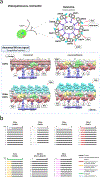Composition and function of ciliary inner-dynein-arm subunits studied in Chlamydomonas reinhardtii
- PMID: 33876572
- PMCID: PMC8217317
- DOI: 10.1002/cm.21662
Composition and function of ciliary inner-dynein-arm subunits studied in Chlamydomonas reinhardtii
Abstract
Motile cilia (also interchangeably called "flagella") are conserved organelles extending from the surface of many animal cells and play essential functions in eukaryotes, including cell motility and environmental sensing. Large motor complexes, the ciliary dyneins, are present on ciliary outer-doublet microtubules and drive movement of cilia. Ciliary dyneins are classified into two general types: the outer dynein arms (ODAs) and the inner dynein arms (IDAs). While ODAs are important for generation of force and regulation of ciliary beat frequency, IDAs are essential for control of the size and shape of the bend, features collectively referred to as waveform. Also, recent studies have revealed unexpected links between IDA components and human diseases. In spite of their importance, studies on IDAs have been difficult since they are very complex and composed for several types of IDA motors, each unique in composition and location in the axoneme. Thanks in part to genetic, biochemical, and structural analysis of Chlamydomonas reinhardtii, we are beginning to understand the organization and function of the ciliary IDAs. In this review, we summarize the composition of Chlamydomonas IDAs particularly focusing on each subunit, and discuss the assembly, conservation, and functional role(s) of these IDA subunits. Furthermore, we raise several additional questions/challenges regarding IDAs, and discuss future perspectives of IDA studies.
Keywords: Chlamydomonas; IDA; cilia; flagella; inner-arm dynein; motility; subunit.
© 2021 Wiley Periodicals LLC.
Conflict of interest statement
Conflict of Interest
The authors declare there is no conflict of interest in this work.
Figures



Similar articles
-
Gene dosage of independent dynein arm motor preassembly factors influences cilia assembly in Chlamydomonas reinhardtii.PLoS Genet. 2024 Mar 18;20(3):e1011038. doi: 10.1371/journal.pgen.1011038. eCollection 2024 Mar. PLoS Genet. 2024. PMID: 38498551 Free PMC article.
-
Functional and structural significance of the inner-arm-dynein subspecies d in ciliary motility.Cytoskeleton (Hoboken). 2024 Nov;81(11):569-577. doi: 10.1002/cm.21828. Epub 2024 Jan 12. Cytoskeleton (Hoboken). 2024. PMID: 38214410 Review.
-
A microtubule-dynein tethering complex regulates the axonemal inner dynein f (I1).Mol Biol Cell. 2018 May 1;29(9):1060-1074. doi: 10.1091/mbc.E17-11-0689. Epub 2018 Apr 9. Mol Biol Cell. 2018. PMID: 29540525 Free PMC article.
-
FAP57/WDR65 targets assembly of a subset of inner arm dyneins and connects to regulatory hubs in cilia.Mol Biol Cell. 2019 Oct 1;30(21):2659-2680. doi: 10.1091/mbc.E19-07-0367. Epub 2019 Sep 4. Mol Biol Cell. 2019. PMID: 31483737 Free PMC article.
-
Functional diversity of axonemal dyneins as studied in Chlamydomonas mutants.Int Rev Cytol. 2002;219:115-55. doi: 10.1016/s0074-7696(02)19012-7. Int Rev Cytol. 2002. PMID: 12211628 Review.
Cited by
-
Novel axonemal protein ZMYND12 interacts with TTC29 and DNAH1, and is required for male fertility and flagellum function.Elife. 2023 Nov 7;12:RP87698. doi: 10.7554/eLife.87698. Elife. 2023. PMID: 37934199 Free PMC article.
-
DNALI1 deficiency causes male infertility with severe asthenozoospermia in humans and mice by disrupting the assembly of the flagellar inner dynein arms and fibrous sheath.Cell Death Dis. 2023 Feb 15;14(2):127. doi: 10.1038/s41419-023-05653-y. Cell Death Dis. 2023. PMID: 36792588 Free PMC article.
-
The intraflagellar transport cycle.Nat Rev Mol Cell Biol. 2025 Mar;26(3):175-192. doi: 10.1038/s41580-024-00797-x. Epub 2024 Nov 13. Nat Rev Mol Cell Biol. 2025. PMID: 39537792 Review.
-
Clinical detection, diagnosis and treatment of morphological abnormalities of sperm flagella: A review of literature.Front Genet. 2022 Nov 8;13:1034951. doi: 10.3389/fgene.2022.1034951. eCollection 2022. Front Genet. 2022. PMID: 36425067 Free PMC article. Review.
-
Multi-scale structures of the mammalian radial spoke and divergence of axonemal complexes in ependymal cilia.Nat Commun. 2024 Jan 8;15(1):362. doi: 10.1038/s41467-023-44577-1. Nat Commun. 2024. PMID: 38191553 Free PMC article.
References
-
- Afzelius BA (1976). A human syndrome caused by immotile cilia. Science, 193(4250), 317–319. - PubMed
-
- Alford LM, Wirschell M, Yamamoto R, & Sale WS (2012). 11 - Control of Axonemal Inner Dynein Arms A2 - King, Stephen M. In Dyneins (pp. 312–335). Academic Press.
-
- Aravind Kumar M, Singh V, Naushad SM, Shanker U, & Lakshmi Narasu M (2018). Microarray-based SNP genotyping to identify genetic risk factors of triple-negative breast cancer (TNBC) in South Indian population. Mol Cell Biochem, 442(1–2), 1–10. - PubMed
-
- Barbar E (2008). Dynein light chain LC8 is a dimerization hub essential in diverse protein networks. Biochemistry, 47(2), 503–508. - PubMed
Publication types
MeSH terms
Substances
Grants and funding
LinkOut - more resources
Full Text Sources
Other Literature Sources

